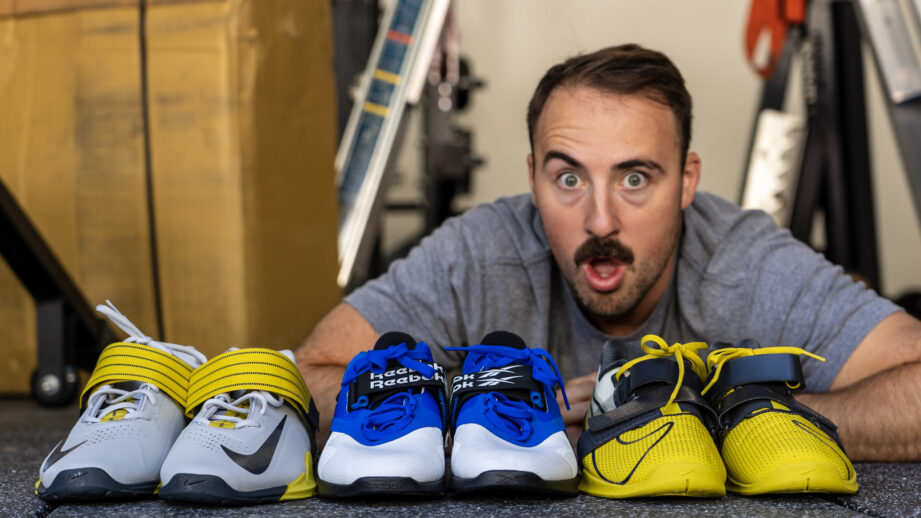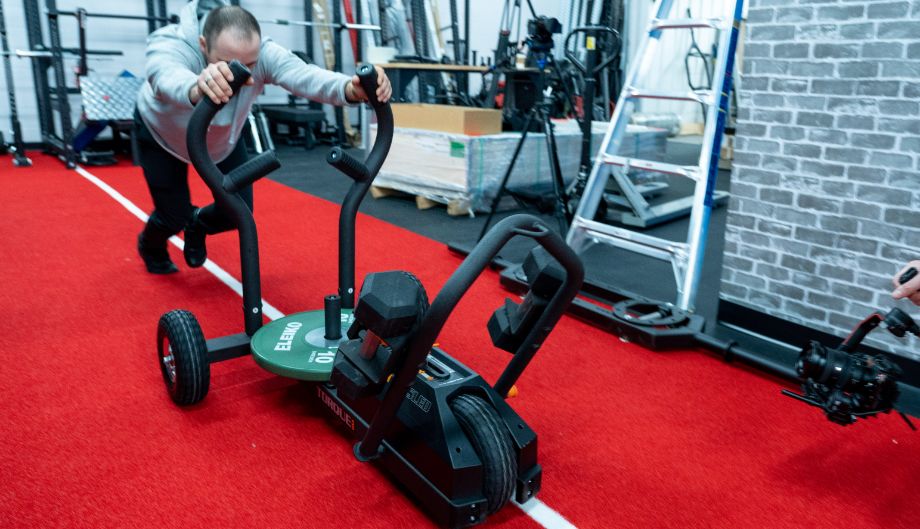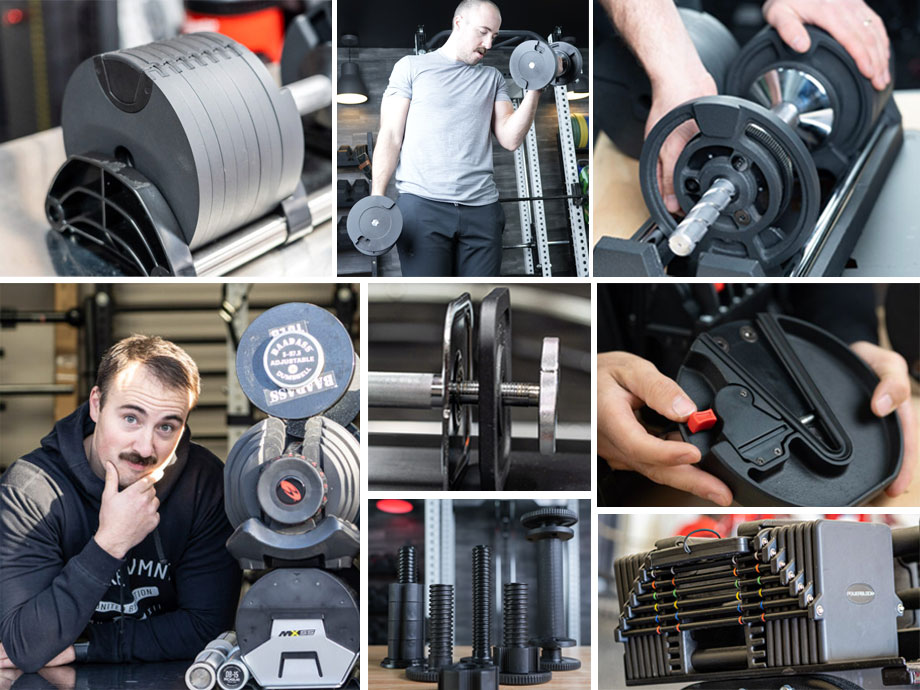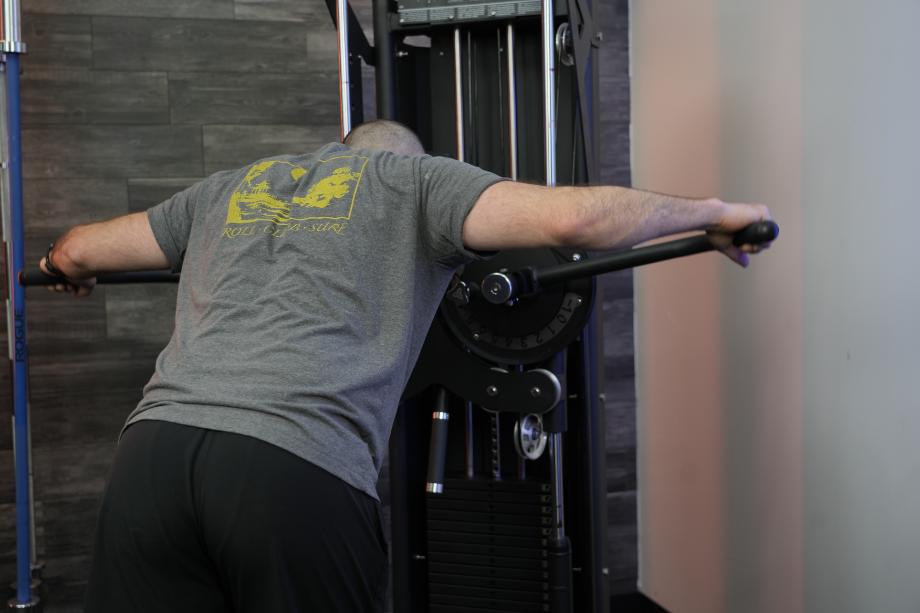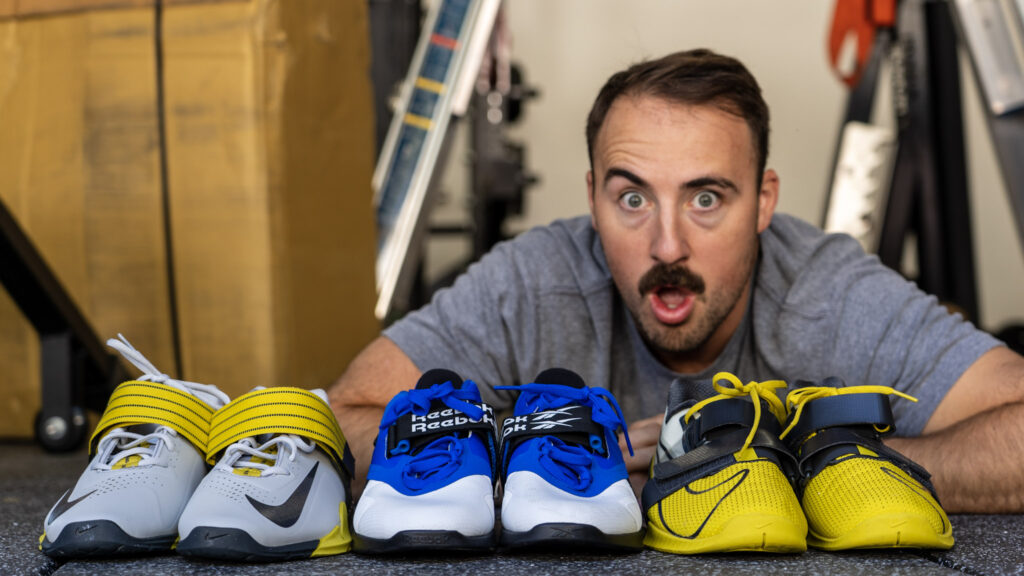
I’ve said it once and I’ll say it again: training shoes can (and will) make or break your workout. Shoes aren’t a training tool to take lightly, as choosing the wrong ones can cause pain or injuries in the long run. Not only that, but the right pair of training shoes can help you achieve new personal records.
Finding the best weightlifting shoes, in particular, is important for making progress in squats, deadlifts, snatches, and clean-and-jerks. For that reason, and because I’m kind of a sneakerhead, my team and I put together this guide to the best weightlifting shoes.
I’ve been lifting weights for most of my life, and many members of the Garage Gym Reviews team are competitive weightlifters or weightlifting coaches who use these shoes during training and competition. Heck, we even have someone who competed at the 2020 Tokyo Olympics on our team.
We personally test each pair of shoes in our home gyms and rate them on a variety of factors, such as:
- Stability: Do we feel grounded in the shoes?
- Versatility: Are they good for only one movement, or are they a multi-faceted shoe?
- Design: This doesn’t impact the functionality but a good-looking shoe is a nice thing to have.
- Price: Are they worth the price tag?
Best Weightlifting Shoes for 2025
- Best Weightlifting Shoes Overall: Nike Savaleos
- Best Minimalist Lifting Shoes: NOBULL Outwork
- Best CrossFit Weightlifting Shoes: Nike Metcon 9
- Best for Powerlifting: Chuck Taylor All-Stars
- Best Weightlifting Shoes for Beginners: adidas Powerlift 5
- Best Weightlifting Shoes for Cross-Training: Reebok Lifter PR 3
- Best Weightlifting Shoes for Wide Feet: TYR L-1 Lifters
- Best Budget Weightlifting Shoes: kcross Weightlifting Shoes
- Best for Olympic Lifting: Nike Romaleos 4
- Best Weightlifting Shoes for Flat Feet: adidas Adipower 3
Best Weightlifting Shoes Overall: Nike Savaleos
Good for: Any fitness enthusiast looking for a great weightlifting shoe at a great price.
Best Overall
Nike Savaleos Weightlifting Shoes
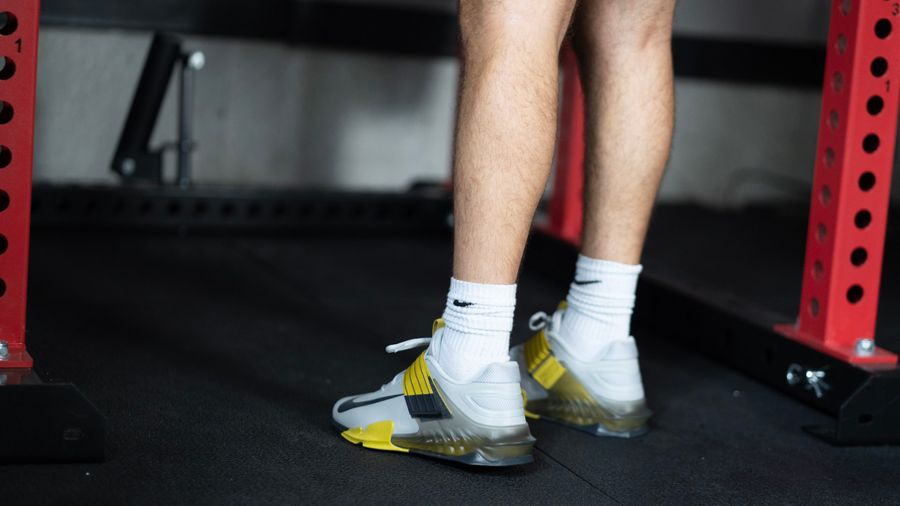
Product Highlights
- Weightlifting shoes
- 15 mm heel drop
- Wide toe box
- Hook and loop strap
Pros & Cons
Pros
- Great shoes at a great price point ($120)
- Wide toe box adds stability to lifts
- Good option for casual lifters and beginners
Cons
- Midsole might be too responsive for people who lift super heavy
- Moderate heel height (15 mm) doesn’t provide the best assistance for squatting
- Limited velcro surface area on straps
Bottom Line
If you’re looking for the best combination of function, style, and price, you can stop right here. The Nike Savaleos are by far the best weightlifting shoes for most people because of their value proposition.
If you’re looking for the best combination of function, style, and price, you can stop right here. The Nike Savaleos are by far the best weightlifting shoes for most people because of their value proposition.
Are they the absolute best in terms of function for Olympic weightlifting? No, I don’t think so—and neither does Tokyo Olympian Caine Wilkes. “The heel height isn’t ideal for Olympic weightlifting, and the midsole is a bit more responsive than I think most elite lifters would want.”
But when you consider the price point and all of the features you get for $125, the Savaleos outperform every other weightlifting shoe in its price range, earning it a 5 out of 5 for value.
The Savaleos are like the little brother to the Nike Romaleos, which I cover below as my top pick for Olympic weightlifting shoes. Nike Savaleos have all of the features you’d expect to see on a pair of lifting shoes: a wide toe box and heel cup, a rigid midsole with an elevated heel, and a velcro strap to lock your feet in place against the base of the shoe.
To clarify, what I’m saying is that the Savaleos are the best value weightlifting shoes. Caine adds, “It’s not made to be a lifting shoe for top-tier elite weightlifters, and that’s OK; most people aren’t looking to be competitive in weightlifting or powerlifting. The midsole is a bit more responsive than most weightlifting shoes, but it’ll be more than enough support and stability for most people and lifting routines.” For most people, the price makes more sense than the $200 price tag of higher-end shoes.
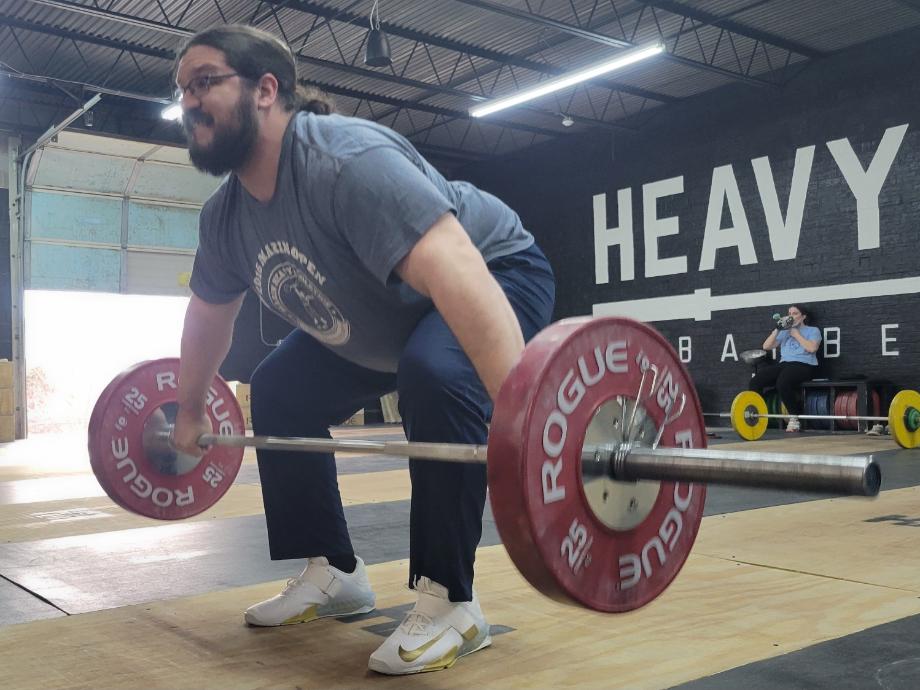
With an effective heel height of 15 millimeters—just over a half-inch—the Savaleos are perfect for acclimating oneself to elevated lifting shoes, as well as for using as a hybrid shoe you can take from the lifting platform to a barbell WOD. That moderate heel height does mean that the Savaleos aren’t the best at providing mobility assistance with squatting—if you need more confidence and depth in your squat, take a look at lifting shoes with a heel of 18-20 millimeters, or about three-quarters of an inch.
Athletes who lift very heavy might notice—as Caine did in his Nike Savaleos weightlifting shoes review—that the Savaleos have a more responsive midsole than other, more expensive weightlifting shoes, which isn’t ideal for moving super heavy barbells. Still, the wide base provides ample stability for both powerlifting and Olympic lifting for the casual athlete.
| Price | $125 |
| Heel drop | 15 mm |
| Upper | Not disclosed |
| Midsole | Rigid midsole |
| Tread | Rubber |
| Size range | Men’s 5/Women’s 6.5 to Men’s 15/Women’s 16.5 |
| Colorways | Black/White/Gray Fog/Laser Orange, White/Black/Iron Gray, White/Metallic Gold/Wolf Gray/Photon Dust, Gray Fog/Clear Emerald/Total Orange |
Best Minimalist Lifting Shoes: NOBULL Outwork
Good for: People who want a versatile but minimalist shoe in function and appearance.
Best Minimalist Lifters
NOBULL Outwork
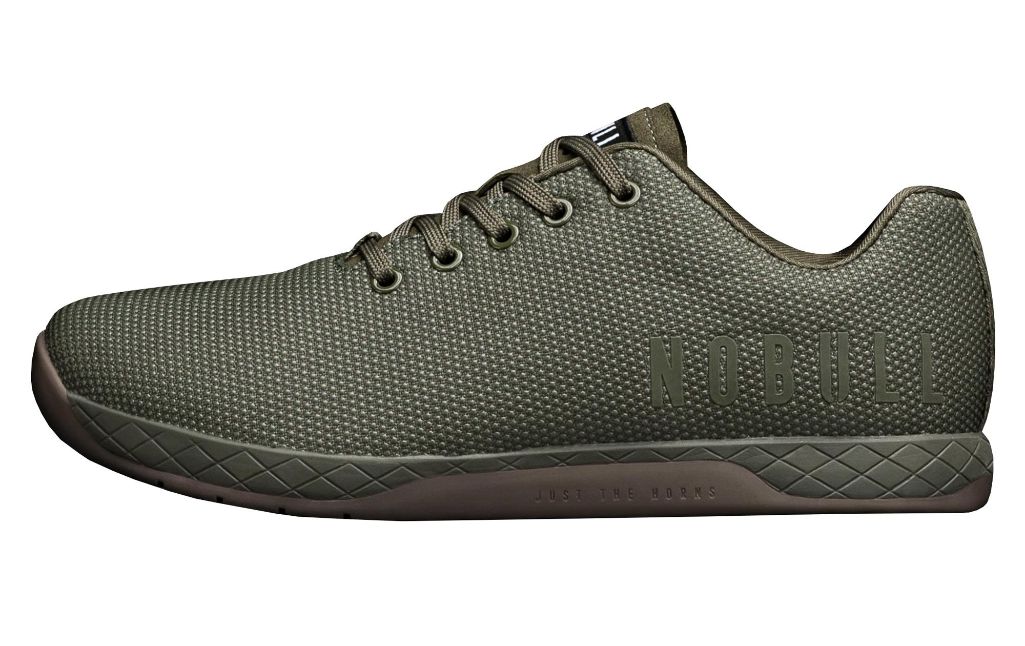
Product Highlights
- 4mm heel-to-toe drop
- Stylish looks
- Versatile
- Durable
- Great for CrossFit
Pros & Cons
Pros
- Performs well across a variety of exercises
- Stylish look
- Durable
- Several height levels
Cons
- Expensive
- Takes a while to break in
- 4mm heel-to-toe-drop may not be good for some movements (such as squats)
Bottom Line
A versatile and durable cross-training shoe with some unique colorways.
NOBULL is one of those love ‘em or hate ‘em brands, as discussed in our NOBULL Outwork review, where members of our GGR team share their very different opinions on these controversial training shoes.
For example, take GGR senior director of content and certified personal trainer Kate Meier’s thoughts: “When I first put on these trainers, I didn’t like the feel; I’m used to higher heels in my lifting shoes. I really didn’t want to like them, but after doing running, squats, and jumping workouts in them, I’m digging the feel of them. They don’t feel uncomfortable in any of those movements.” She rates the ergonomics a 4.5 out of 5.
If you’re after a minimalist pair of shoes in both function and aesthetics, you might be one of those people that turns into a die-hard NOBULL fanatic who wears their utilitarian-style trainers for everything from maxing out to running a mile. If not, move along and keep reading about our other top picks for weightlifting shoes.
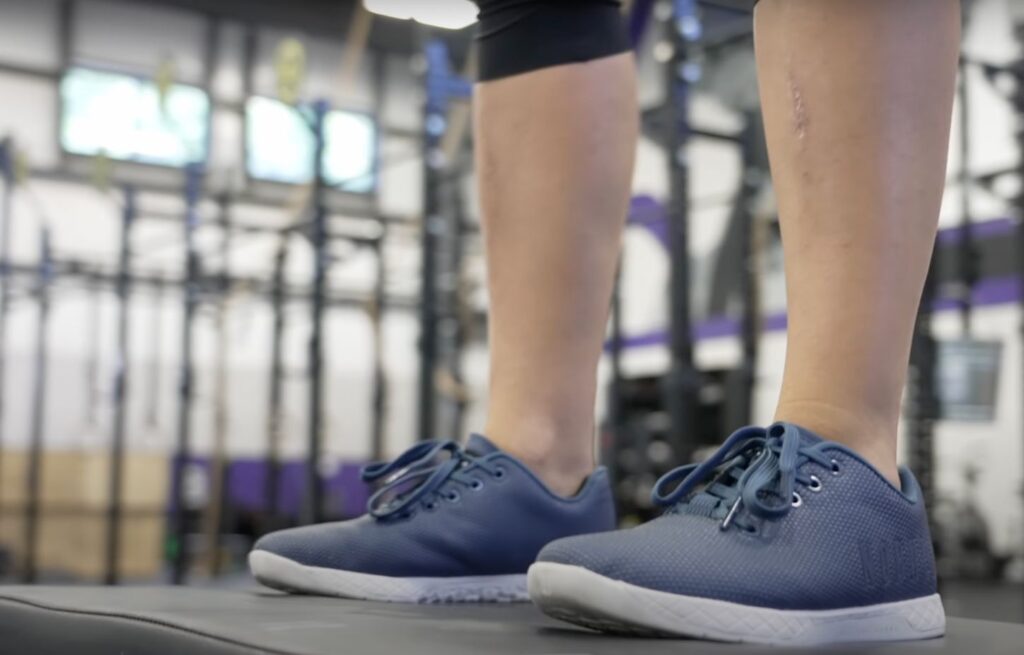
Like the Nike Metcons, the NOBULL Outworks aren’t technically weightlifting shoes. They don’t feature a raised heel (the heel-to-toe drop is only 4 millimeters); they don’t have straps for added security, and they aren’t designed with the wide heel cup or toe box that most lifting shoes have.
Instead, the NOBULL Outwork features a slimmer profile and prioritize durability over everything else. Thanks to that focus on durability, I find the NOBULL Outworks to be a tad heavier than other cross-training shoes, a characteristic that lends itself well to lifting weights. The flat midsole and outsole create a stable base, and the shape of the toe box, though not super wide, gives your toes enough space to spread out and aid with balance.
Keep in mind, NOBULL does make legit weightlifting shoes. I just don’t recommend them because I find them to be overrated, and I don’t actually know anyone who likes them.
| Price | Starts at $139 |
| Heel drop | 4 mm |
| Upper | SuperFabric mesh |
| Midsole | Phylon (EVA) |
| Tread | Carbon rubber |
| Size range | Men’s 8-18/Women’s 4.5-16 |
| Colorways | Over 50 options |
Best CrossFit Weightlifting Shoes: Nike Metcon 9
Good for: People who want a versatile shoe they can do just about anything in.
Best for CrossFit
Nike Metcon 9
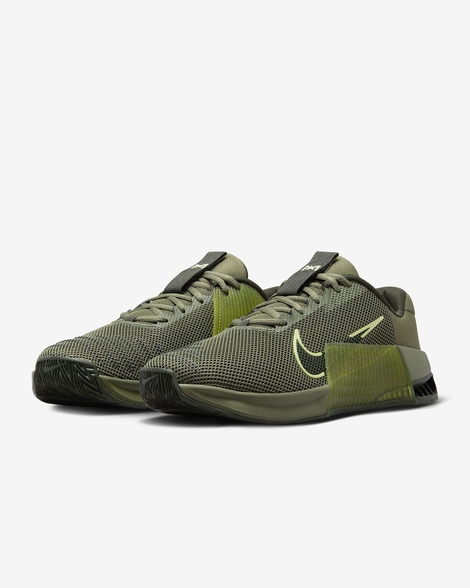
Product Highlights
- Released August 2023
- Versatile, durable training shoe
- Meant for CrossFit workouts and training
- Enhanced rope guard
- Larger Hyperlift crash pad
- 11 colorways available at launch
Pros & Cons
Pros
- Versatile training shoe
- Rope guard wrap-around
- Rigid heel great for stability
- Multiple colorways to choose from
- Lace locking system
- High-traction outsole
- Durable upper
- Breathable woven textile upper
- Wide toe box
Cons
- Not great for running or WODs with longer run intervals
- Some people may find them too rigid
- Expensive at $150 a pair
Bottom Line
The Nike Metcon 9 training shoes were released in August 2023 and build upon the Nike Metcon 8s with an enhanced rope guar wrap-around, plus a larger and more rigid crash pad. They feature a tightly woven and durable, but breathable, upper. The patterned, grooved outsole provides great traction during most weather conditions.
Okay, so, we’re stretching the term “weightlifting shoes” here, because the Nike Metcon 9s are technically cross-training shoes. They’re CrossFit shoes designed specifically to withstand the variety of movements you’ll encounter during CrossFit WODs.
But in our experience, lots of people who are looking for lifting shoes are actually just looking for shoes with a wide, flat outsole; enough stability to crush a three-rep max squat; and enough flexibility to take on box jumps and barbell cycling, too. And that shoe, friends, is the Nike Metcon 9.
I think that Nike has changed everything about this shoe, including the platform, which is the most significant part, leading me to rate the stability of the shoe a 5 out of 5.
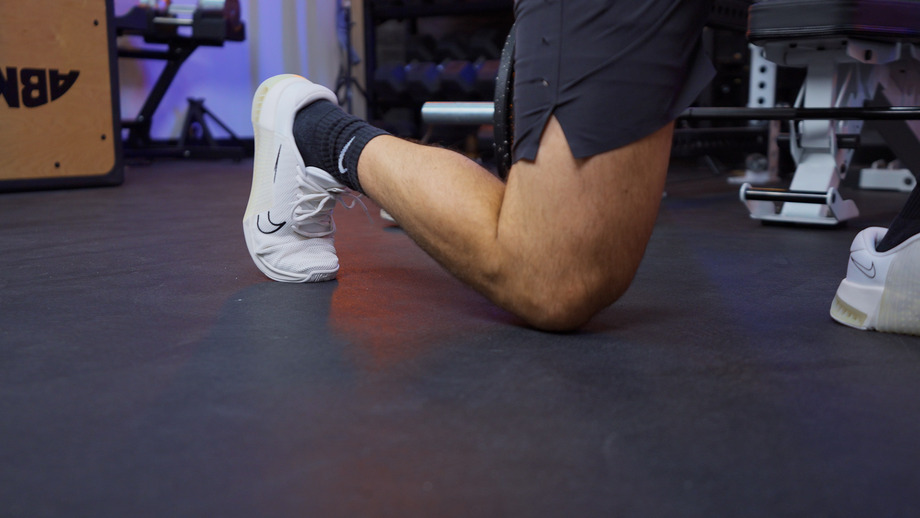
I love the Metcons for their ability to take on every type of grueling workout without sustaining much damage to the structure or aesthetics. They were built with durability and stability top-of-mind. They do take a while to break in because of that, but you’ll find the break-in period well worth it when you’re transitioning from the strength portion of your workout to the conditioning portions without stopping to change shoes.
RELATED: Best Cross-Training Shoes
The $160 price tag may seem steep, but when you look at your other options for cross-trainers, the Nike Metcons aren’t outrageously priced. Nike also has an awesome return policy that allows you to return the shoes within 60 days even if they’re worn. The two-year warranty on top of that makes for a great customer experience.
Read our full Nike Metcon 9 review.
| Price | $150 to $180 |
| Heel drop | 4 mm |
| Upper | Woven textile |
| Midsole | Dual-density foam |
| Tread | Patterned, grooved rubber |
| Size range | Women’s 5-12, men’s 3.5-15 |
| Colorways | 16 options, plus design-your-own option |
Best for Powerlifting: Chuck Taylor All Stars
Good for: Powerlifters who want an inexpensive shoe with a flat, stable base.
Best for Powerlifting
Converse Chuck Taylor All-Star
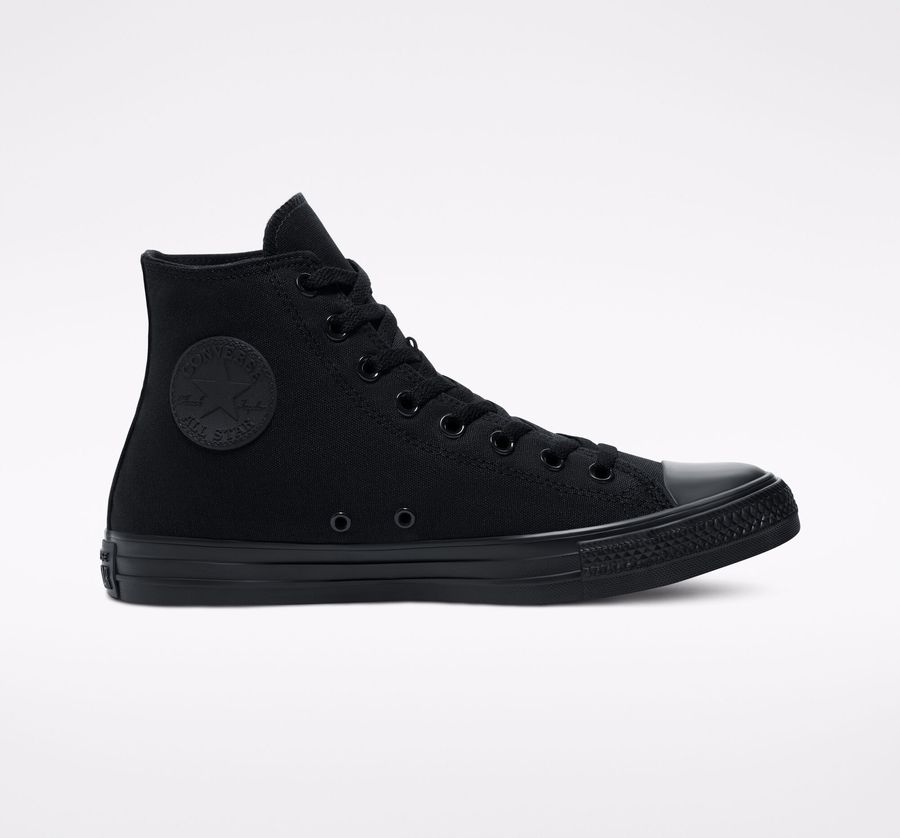
Product Highlights
- Sturdy rubber outsole
- Minimal heel-to-toe drop
- Minimalist design
- Budget-friendly
- Lace closure mechanism
Pros & Cons
Pros
- Flat heel is perfect for deadlifts
- Can get them in low-tops and high-tops
- Minimal midfoot cushioning won’t flex under heavy lifts
Cons
- Minimal heel-to-toe drop won’t help with back squats
- Narrow through the midfoot
- Canvas construction isn’t highly durable
Bottom Line
A classic shoe that performs well on the powerlifting platform and the streets.
Ah, I just love a good classic. Converse All Stars are some of the greatest shoes in existence for general wear, but they’re also straight up awesome for powerlifting—particularly deadlifts.
RELATED: Best Deadlift Shoes
Lots of powerlifters love to train barefoot, and with All Stars, you can get a barefoot feel thanks to the minimal drop. But, you’ll also still enjoy the stability of a rigid outsole. It’s truly the best of both worlds in my opinion. Also helpful is the ankle support you get if you choose the high-top version.
RELATED: Xero 360 Training Shoes Review
Additionally, many powerlifters like to feel grounded when lifting, and All Stars provide that feeling thanks to the thin and flat midsole. “The sole is very firm, with enough cushioning to keep your foot comfortable, but not quite as much as running shoes,” says Matt Dustin, CES, PN1-NC, rating the durability of the shoe a 4 out of 5. The upper of the shoe is constructed from a simple canvas fabric, which is super breathable and somewhat flexible, giving you some room to wiggle and spread out your toes.
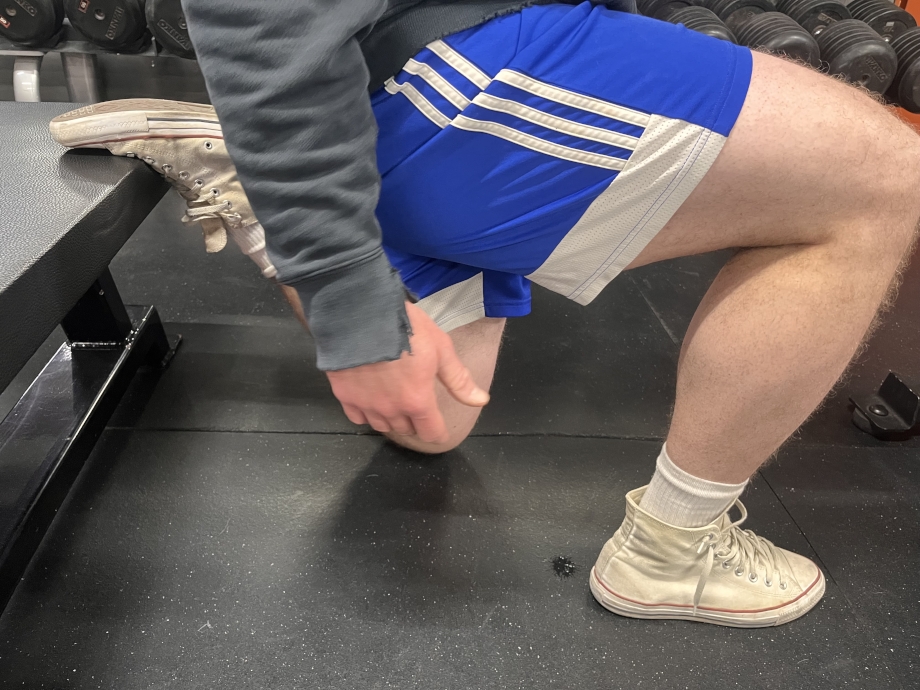
Not to mention, Chucks are cheap! For $65, you can get a pair of solid powerlifting shoes that will last you several training cycles and competitions. Matt himself used it for several years for powerlifting and general strength training.
These shoes won’t be the best squat shoes for everyone, especially those who need an elevated heel to help reach the full depth. Some powerlifters may wish to utilize Converse for deadlifts and bench presses, but wear other shoes for their squat.
Read our Converse Chuck Taylor All-Star review for more information on these gym shoes.
| Price | $65 |
| Heel drop | 0 mm |
| Upper | Canvas |
| Midsole | OrthoLite Cushioning |
| Tread | Rubber |
| Size range | Men’s 3/Women’s 5 to Men’s 16/Women’s 18 |
| Colorways | Black, Blue, Gray, Red, White, Pink, Customizable |
Best Weightlifting Shoes for Beginners: adidas Powerlift 5
Good for: Beginner weightlifters who want to dip their toes in the water without spending a ton of money
Best for Beginners
Adidas Powerlift 5
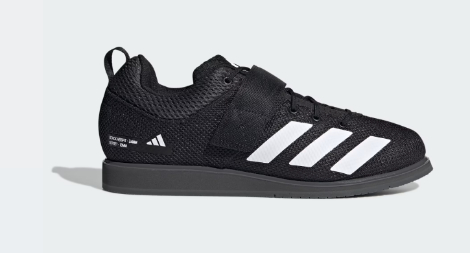
Product Highlights
- 16mm heel lift
- Durable construction that provides stability and grip
- Excellent choice for beginners who want to try weightlifting shoes
- Narrow toe box may require some to go up half a size
Pros & Cons
Pros
- Good entry-level lifting shoe at only $130
- 16mm effective heel height
- Sturdy construction with a minimalist design
- Grippy, stable sole
Cons
- Toe box may be too narrow for some
- Not meant for cross-training or running
- Upper isn’t very breathable
Bottom Line
The Adidas Powerlift 5 is a great choice for those who want to try a weightlifting shoe without breaking the bank, and is very reasonably priced compared to many Olympic lifting shoes.
The Powerlift 5 is a no-frills weightlifting shoe with a moderately elevated heel, maneuverable canvas upper construction, and an EVA foam midsole at a nice price point.
Generally, I don’t recommend weightlifting shoes with EVA midsoles because EVA foam is much more compressible than rigid TPU, wood, or stacked leather. However, I do think that the EVA heel on the Powerlifts is a great option for beginner lifters. Combined with the 16-millimeter heel height, this shoe is made perfectly for people who want to slowly acclimate to weightlifting shoes.
Even with the EVA midsole, these shoes are pretty stable in practice, leading GGR staff writer Matt Dustin, CES, PN1-NC, to rate the stability and performance a 5 out of 5. “The sole is very firm, and with the built-in strap, you can make these as tight as you want,” Matt adds.
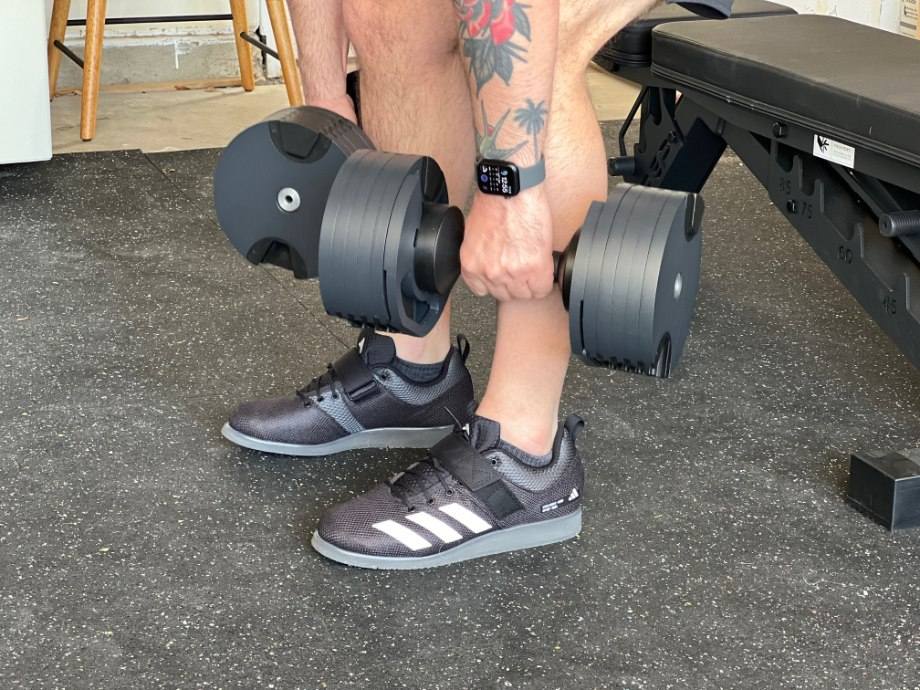
It can feel like a big change going from flat cross-training shoes or running shoes to Olympic lifting shoes with a 0.75-inch (19mm) heel made of hard plastic. The Adidas Powerlift shoes are a middle ground to get started on.
They aren’t the cheapest shoes at $130, although it still beats top lifting shoes. However, Matt notes that he often finds them on sale on adidas’ website. If you’re patient, you can wait for the next sale to save some money.
As you become more advanced and start lifting heavier weights, you may want to upgrade to something more heavy-duty, like the Nike Romaleos. At very heavy weights, the EVA foam heel might become too responsive and compressible, leading to a decrease in stability. But for those just starting out, it’s unlikely the shoes will reach that point—and honestly, a bit of platform feedback isn’t a bad thing for beginners.
Check out our adidas Powerlift 5 review.
| Price | $130 |
| Heel drop | 16 mm |
| Upper | Canvas |
| Midsole | High-density EVA foam |
| Tread | Rubber |
| Size range | Men’s 4/Women’s 5 to Men’s 16/Women’s 17 |
| Colorways | 6 options |
Best Weightlifting Shoes for Cross-Training: Reebok Lifter PR 3
Good for: Lifters who want a lifting shoe responsive enough for hopping into barbell cycling metcons
Best for Cross-Training
Reebok Lifter PR III
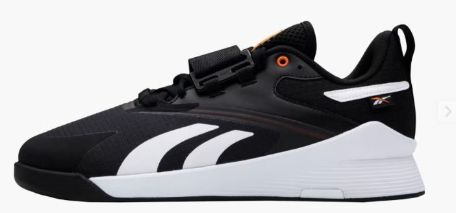
Product Highlights
- 18mm heel-to-toe drop
- Around $100
- Imported
- Rubber outsole
Pros & Cons
Pros
- 18mm heel-to-toe drop
- Rubber outsole for traction
- 5 colorway options
- Affordable for a weightlifting shoe
Cons
- Not a versatile shoe
- Midsole is too responsive for heavier lifts
- Heel cup may deteriorate
Bottom Line
An incredibly affordable weightlifting shoe that's good for one thing—weightlifting.
The Reebok Lifter PR 3 shoes are very similar to the adidas Powerlift 5s described above. From price to performance, they have a lot in common.
Competitive lifter and weightlifting coach Emelie Wilkes, USAW-L1, tried out the Lifter PR 3 and immediately noticed the more responsive heel, made of a dense EVA foam. She says, “I felt springy on my first day using it. The responsiveness makes for a versatile lifting shoe, but I don’t think it’s ideal for heavy lifting.” She rates the stability a 4 out of 5.
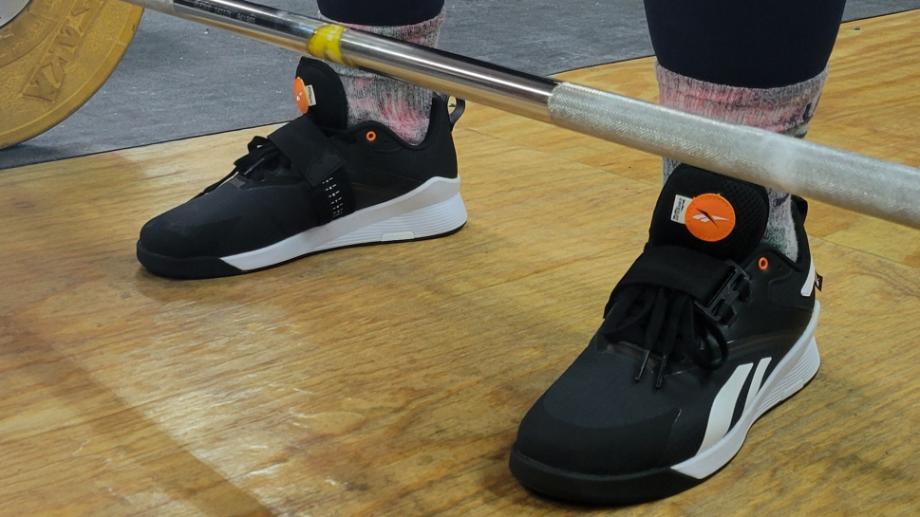
The responsive foam makes for a versatile shoe, however. They remain supportive and stable enough for strength sessions, but prove responsive enough for most metcons (as long as they don’t have running). The moderate heel height strikes a good balance between keeping squat positions but remaining low enough to feel comfortable in other movements. Emelie rates the versatility a 4.5 out of 5.
That’s part of the reason these shoes have such good value. Sure, there are other shoes on this list that cost around or less than $100, but you can quite literally use the Lifter PRs for almost every type of workout. If you’re not running or doing ballistic movements like box jumps regularly, you may not even need a second pair of workout shoes.
Of course, having a dedicated pair of shoes for all types of workouts would be ideal, but that’s not realistic for everyone. Based on Emelie’s experience, if you want to lift some and sprinkle in other activities now and again, the Lifter PR 3s are probably the best budget-friendly choice for you. If you want to focus on heavy lifting, these might not be ideal.
Read our in-depth Reebok Lifter PR 3 review to get our full thoughts.
| Price | $110 |
| Heel drop | 15 mm |
| Upper | Breathable textile |
| Midsole | EVA foam |
| Tread | Rubber |
| Size range | Men’s 5/Women’s 6.5 to Men’s 15/Women’s 16.5 |
| Colorways | Court Brown/Black/White; Black/Pure Grey/Reebok Lee; White/Black/Gum; Black/White/Smash Orange; Black/Pure Grey/Gum |
Best Weightlifting Shoes for Wide Feet: TYR L-1 Lifters
Good for: Weightlifters wanting a roomy lifting shoe that lets their toes splay
Best for Wide Feet
TYR L-1 Weightlifting Shoes
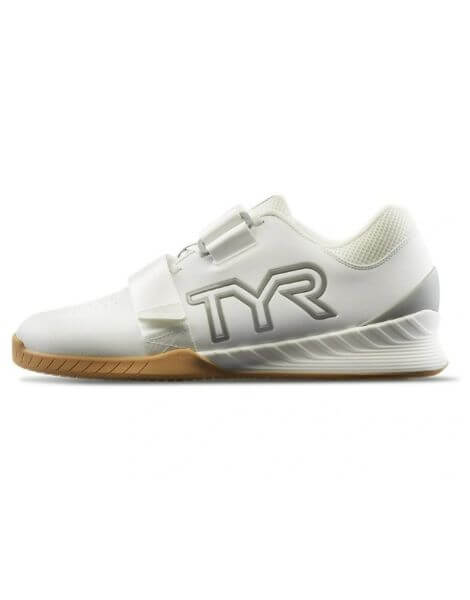
Product Highlights
- Engineered in conjunction with Squat University
- 21-mm heel-to-toe drop and a wider forefoot
- Back heel support and patent pending anatomical toe box
- Features a durable, heavy leather upper, rubber outside, additional outsole wrap on toe box for durability
Pros & Cons
Pros
- Extra-wide toe box and forefoot
- Steep heel-to-toe drop
- Durability
- Rubber outsole won’t slip
Cons
- Not available en masse yet
- May be too wide in the toe box for some
Bottom Line
If you are on the hunt for a premium pair of lifting shoes with a big heel-to-toe drop, wider toe box, and heel support, the TYR L-1 Lifter may be for you.
Not all shoes are created equal, and that goes for sizing, too. If you struggle with wide feet, I’d suggest the TYR L-1 Lifters. These shoes are specifically designed with a patent-pending anatomical toe box, allowing for toes to splay and providing a roomier fit than most weightlifting shoes.
TYR released their lifters in late 2022, and they’ve quickly become a staple in the weightlifting community. With a 21-millimeter heel-to-toe drop, the raised heel is ideal for the snatch, clean and jerk, and squatting. Our GGR tester Amanda Capritto, CPT, CES, CNC, CF-L1, CSNC, rated the stability a 4 out of 5, as the TPU heel felt solid during her squats. “I felt plenty stable and as snug as a bug in a rug,” Amanda says.
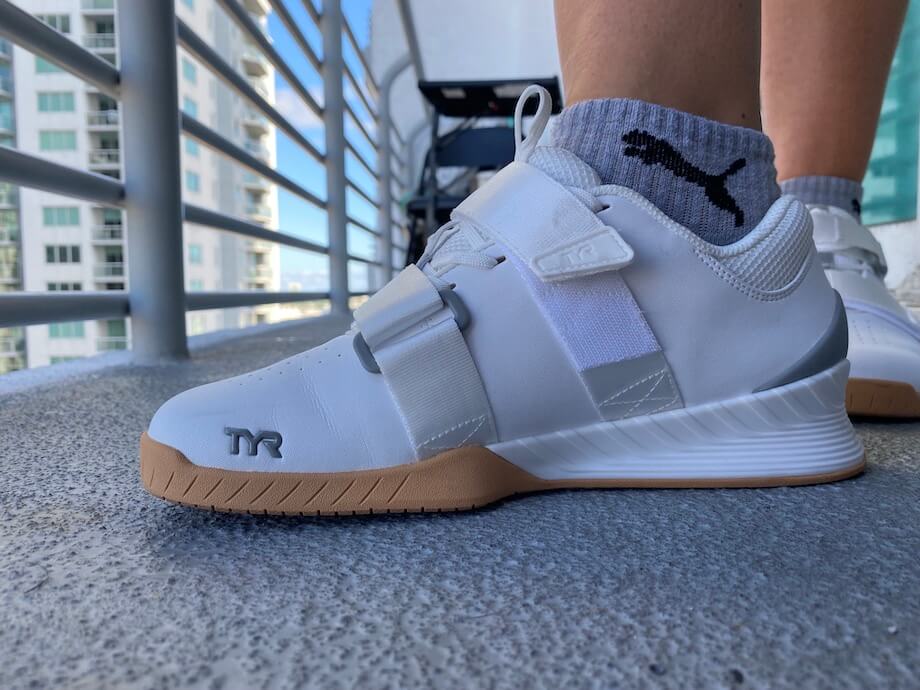
Amanda appreciates the wider toe box, but also sees that someone with narrow feet might have trouble with the shoes. “I found the shoes to be slightly loose around the midfoot, even with the dual straps tightened up,” she recalls. “If you have narrow feet, this could be even more problematic for you.”
Still, for wider feet, this is a fantastic option, even at its higher price of $200. Plus, it’s the shoe of choice for some Team USA weightlifters and Olympians, such as Paris-bound Hampton Morris or Tokyo silver medalist Kate Vibert.
Check out our TYR L-1 Lifters review for more information on these Olympic lifting shoes.
| Price | $200 |
| Heel drop | 21 mm |
| Upper | Perforated faux leather |
| Midsole | TPU |
| Tread | Rubber |
| Size range | Men’s 4.5/Women’s 6 to Men’s 14/Women’s 15.5 |
| Colorways | 11 options |
Best Budget Weightlifting Shoes: kcross Weightlifting Shoes
Good for: Lifters who want a solid, stable shoe for weightlifting at a low price
Best Budget Lifters
kcross Weightlifting Shoes
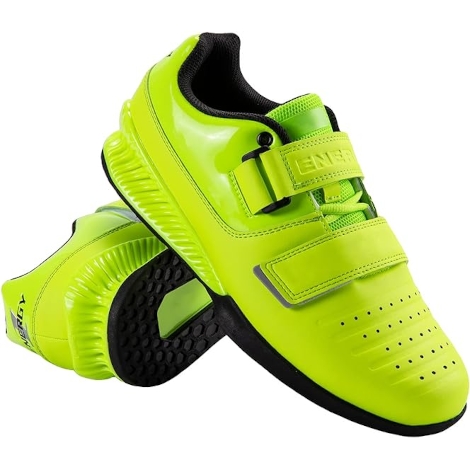
Product Highlights
- Budget-friendly weightlifting shoe
- Sturdy outsole
- Nylon upper
- 20-mm heel-toe drop
- Dual Velcro straps
Pros & Cons
Pros
- Inexpensive
- Quality heel and outsole
- 20-mm heel-toe drop
- Stable performance
Cons
- Limited sizes
- No warranty
- Customers report a narrow toe box
Bottom Line
The kcross Weightlifting Shoes are a durable pair of lifting shoes with a very low price point for lifting shoes. For $70, the heel is extremely similar to higher end shoes like the Nike Romaleos. Although sizes are limited and the toe box is reported as being narrow, these are a solid pair of lifting shoes.
I get it—weightlifting shoes are expensive, with many top brands and shoes costing $200 or more for a pair. Even budget-friendly shoes are still over $100. If you’re trying not to spend too much on a decent lifting shoe, the kcross Weightlifting Shoes are a steal: $70 for a pair with stability that rivals top lifting shoes.
Competitive weightlifter Emelie Wilkes, USAW-L1, tried out the kcross Weightlifting Shoes and felt incredibly stable in them, rating them a 5 out of 5 for stability. “The TPU heel flares out like high-end shoes, and therefore feels very stable when squatting or snatching,” Emelie explains.
With a 20-millimeter heel-to-toe drop, these are ideal for snatches, clean and jerks, and squats. While you may not want to CrossFit in these (and you definitely shouldn’t run in them), you can still do just about all of your strength work in these shoes, earning them a 4 out of 5 for versatility.
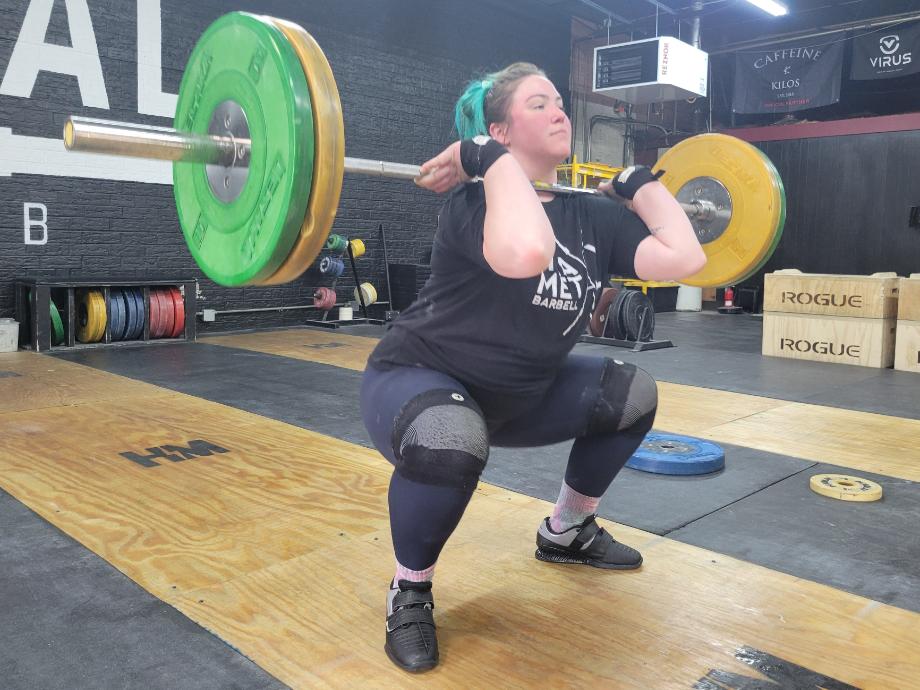
The dual straps and laces allow for an extremely secure feel that’s still comfortable, too. The one drawback of these shoes is that sizing is limited, as shoes only run from a men’s size 6.5 to size 12, or a women’s size 8 to size 13.5. Still, if your shoe size fits the limited range of the kcross shoes, these are quite a deal, earning a 5 out of 5 for its value.
You can check out our kcross Weightlifting Shoes review for more of our thoughts.
| Price | $69.99 |
| Heel drop | 20 mm |
| Upper | Nylon |
| Midsole | TPU |
| Tread | Rubber |
| Size range | Men’s 6.5/Women’s 8 to Men’s 12/Women’s 13.5 |
| Colorways | Meadow Green, Obsidian Black, Coral Orange, Ivory White |
Best for Olympic Lifting: Nike Romaleos 4
Good for: Athletes serious about maximizing Olympic lifting performance.
Best for Olympic Lifting
Nike Romaleos 4
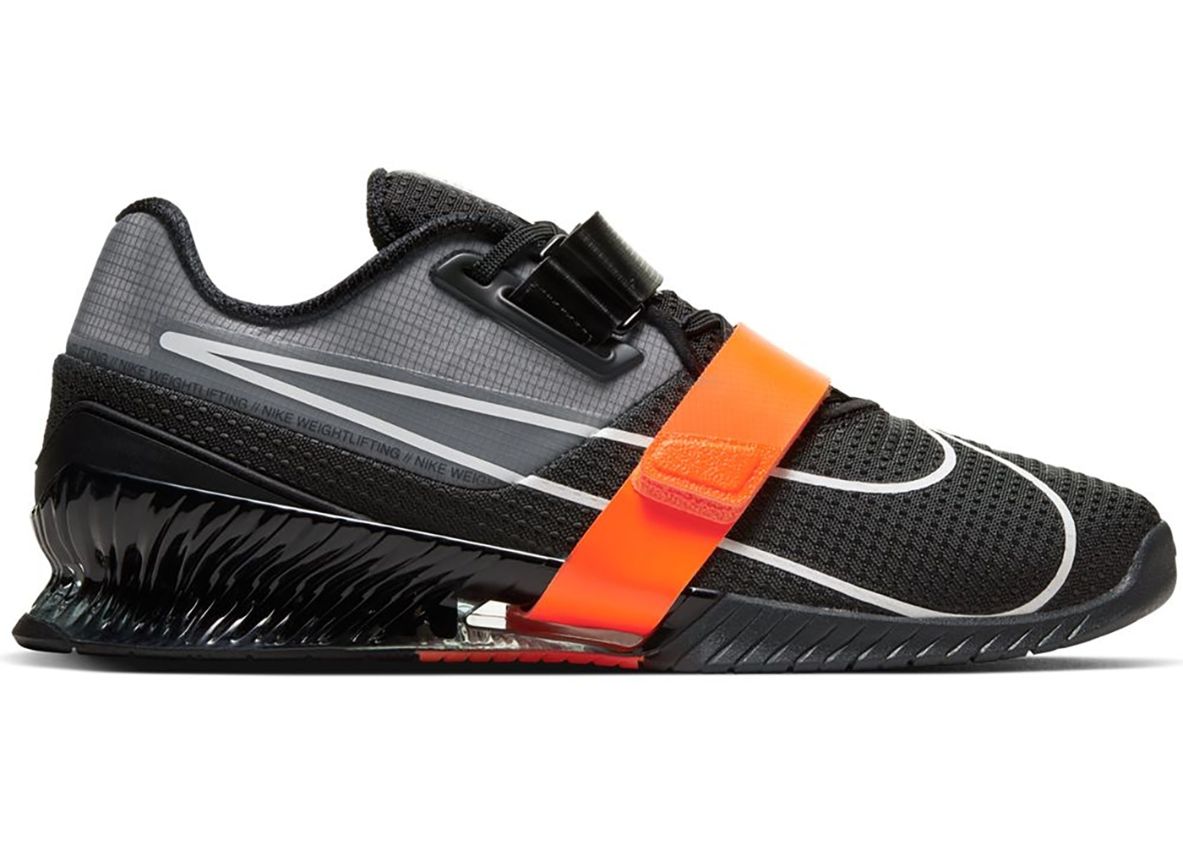
Product Highlights
- Latest iteration in this line of weightlifting shoes
- Blends the breathability of the Romaleos 3 with the sturdy outsole of the Romaleos 2
- 20mm heel drop as well as dual velcro straps
Pros & Cons
Pros
- Incredibly stable platform and midfoot
- Wider toe box than the previous Romaleos
- Heavy and sturdy–I feel like I’m rooted into the ground
Cons
- The laces and straps feel a bit flimsy, but laces can be replaced, and the straps don’t need to do much work if the laces are tied.
- The different materials that are used to make the shoes more breathable also make me wonder how long they will actually last.
- The $200 price will likely limit these shoes to serious athletes.
Bottom Line
The Romaleos 4 were designed to represent the favorable parts of all versions, and I do believe Nike has executed that well. While the price tag of $200 may deter some, this shoe is a great option for those seeking a sturdy, aesthetically pleasing weightlifting shoe.
GGR founder Coop Mitchell was absolutely stunned at the Nike Romaleos 4. “Do I think they surpass the utter awesomeness that was the Nike Romaleos 2?” he asks, answering his own question with, “No. But I think they come really close.” (The Romaleos 2 were honestly the epitome of the best weightlifting shoe ever designed, and it remains a mystery to lifters all around the world why Nike won’t just bring them back.)
Anyway, the Romaleos 4 combines function and style in a way I don’t think any other weightlifting shoe has before. They look fantastic and they feel phenomenal on the platform, leading Coop to rate the appearance of the shoes a 5 out of 5.
They’re heavy, so they make you feel like you can really dig your heels into the ground. The wide base and flared heel increase that element of stability. With a 20-millimeter (0.75-inch) heel height, the Roms provide optimal support for squatting to full depth and receiving the barbell in an upright position. This ultimately increases your chances of a successful lift every time.
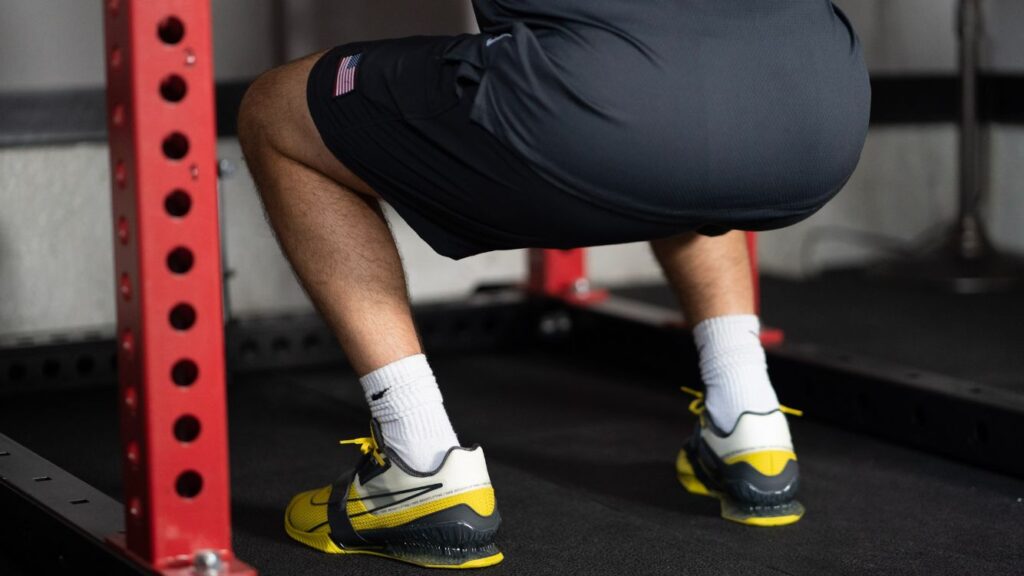
Unfortunately, these fourth-gen Roms are expensive. At $200, it’s unlikely that these are in an acceptable price range for novice weightlifters or even experienced but casual weightlifters. For people who don’t take Olympic lifting that seriously or aren’t sure if they’ll stick with it, $200 for a pair of shoes—no matter how aesthetic or functional—probably doesn’t seem like a justifiable expense. However, for athletes who hit the platform multiple times per week or have intentions of competing at any level, the Nike Romaleos 4 are a worthwhile investment.
Read Coop’s full Nike Romaleos 4 review.
| Price | $200 |
| Heel drop | 20 mm |
| Upper | Mesh fabric |
| Midsole | TPU |
| Tread | Rubber |
| Size range | Men’s 3.5/Women’s 5-Men’s 15/Women’s 16.5 |
| Colorways | Black/Black/White, White/White/Black, Black/Metallic Gold/White/Metallic Gold, White/Bright Crimson/Pink Blast/Black |
Best Weightlifting Shoes for Flat Feet: adidas Adipower 3
Good for: Weightlifters looking for a shoe with nice arch support
Most Versatile Weightlifting Shoes
Adidas Adipower III
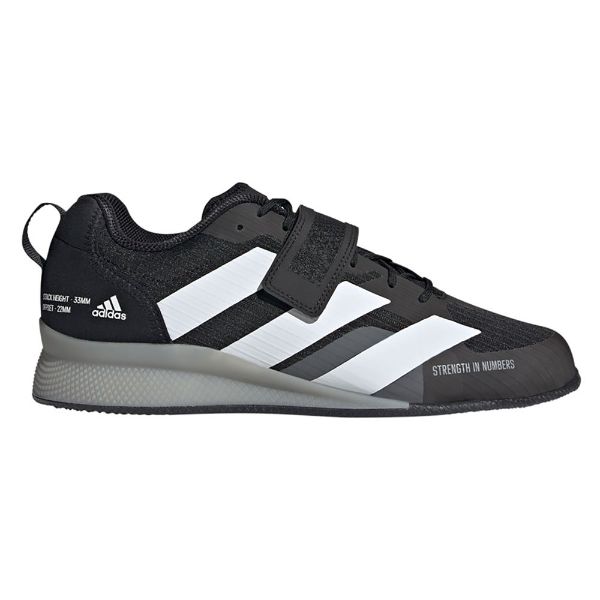
Product Highlights
- High, 22-mm heel great for squatting and Olympic movements
- Comes in men’s and women’s sizes
- Breathable upper
Pros & Cons
Pros
- 22 mm heel
- Wide range of sizes for men and women
- Lace and Velcro closure system
- Uses recycled materials
- High-density midsole
- A unique ripstop upper to give strong support yet remain breathable
- Perforated toe holes to enhance airflow without sacrificing stability
Cons
- Expensive around $220
- Meant for weightlifting, not running or plyometric exercises
Bottom Line
The Adidas Adipower III is the latest iteration of this weightlifting shoe that features a high heel, sturdy midsole, and great feedback.
If you suffer from flat feet or overpronation, the adidas Adipower III has solid insole support that’ll help position your feet in proper positions under heavy loads.
The Adipower III has been a favorite among functional fitness enthusiasts for years. This is because adidas somehow managed to create a shoe that embodies the essentials of a good weightlifting shoe (elevated heel, hook-and-loop strap, rigid base) and the essentials of a cross-training shoe (durability, flexibility) at the same time.
In addition to arch support, the Adipowers have one of the highest heels among weightlifting shoes, clocking in at 22 millimeters. This height provides supreme support for squatting and receiving the bar, regardless of the weight you’re working with. They still keep enough flexibility for barbell exercises, too.
RELATED: Barbell Exercises
There’s a ton of forefoot flexibility in the Adipowers, which can be a good thing or a bad thing depending on what exactly you want. The flexibility makes them great for spreading your toes out and gripping the ground, but that may not be ideal depending on your intended use of weightlifting shoes. For functional fitness athletes, it’s definitely a positive attribute.
At a price point of $230, the Adipowers aren’t cheap at all. And because of their unique application—not quite perfect for weightlifting, not quite perfect for conditioning, but pretty good at both—the price tag might turn a lot of buyers off.
The bottom line is if you’re looking for a shoe that provides good support, yet is flexible enough to wear during some lighter functional fitness workouts, the Adipowers are a great choice.
For more on these shoes, check out our full adidas Adipower 3 review.
| Price | $230 |
| Heel drop | 22 mm |
| Upper | Ripstop that uses at least 50% recycled materials |
| Midsole | TPU |
| Tread | Rubber |
| Size range | Men’s 4/Women’s 5 to Men’s 16/Women’s 17 |
| Colorways | 11 options |
Best Weightlifting Shoes for Women
Sike! We don’t recommend any specific pair of weightlifting shoes for women, because for one, very few options actually come in women-specific sizes and colorways. Second, all of the above shoes would be exactly the same whether they’re labeled as men’s or women’s, other than the sizing. So ladies, just remember to order a size and a half or two sizes down from your normal size when you buy any of the weightlifting shoes we recommend.
Other Weightlifting Shoes We’ve Tested
Rogue Fitness Do-Win Weightlifting Shoes: The Do-Win Classic Lifter, formerly a product of Pendlay (and still beloved by the weightlifting community), gives off old-school lifting vibes thanks to the stacked leather heel that looks like wood. The price point of $125 is also great, but I don’t have confidence that these will hold up over time.
Reebok Legacy Lifter 3: The Legacy Lifters are great weightlifting shoes. They’re probably most similar to the Nike Romaleos, as they feature the same wide base and flared heel. They’re also the same price as the Romaleos. For that price point, we like the Romaleos better because they have two velcro straps versus one, plus the rubber outsole feels more grippy and less selective than it does on the Legacy Lifters.
NOBULL Lifter: The NOBULL Lifters are certainly a cool-looking shoe, however, for the price, they leave a lot to be desired. The leather feels cheap and the stacked leather heel, although aesthetically pleasing, isn’t the most modern construction that you’d expect for what you pay. Similar to their Trainers, I like the look, but the performance doesn’t stack up to the price or the competition.
Reebok Nano X1: We love the Nano X1s for CrossFit workouts and basically any other type of workout you can think of. However, when it comes to CrossFit lifting shoes, the Nike Metcon 7s usurp the Nanos thanks to their flat sole and wider toe box. Comparatively, the Nanos has more cushioning and a narrower forefoot.
How We Tested the Best Weightlifting Shoes
Someone on the Garage Gym Reviews team has actually worn each of these shoes on their feet during lifting workouts. I’ve worn most of them myself. And some of them—like the Reebok Lifter PRs and Nike Romaleos—have been in use by teammates through several years and iterations of the shoes.
In addition to our hands-on experience with all these shoes, I’ve done the research to understand the value proposition of each shoe and really tease out who, exactly, would benefit from a specific pair of weightlifting shoes.
We look at several key points when testing weightlifting shoes:
- Materials and construction
- Heel support and heel-to-toe drop
- Performance in squats, Olympic lifts and other weighted movements
- Durability and rigidity
- Customer reviews
What are Weightlifting Shoes Used For?
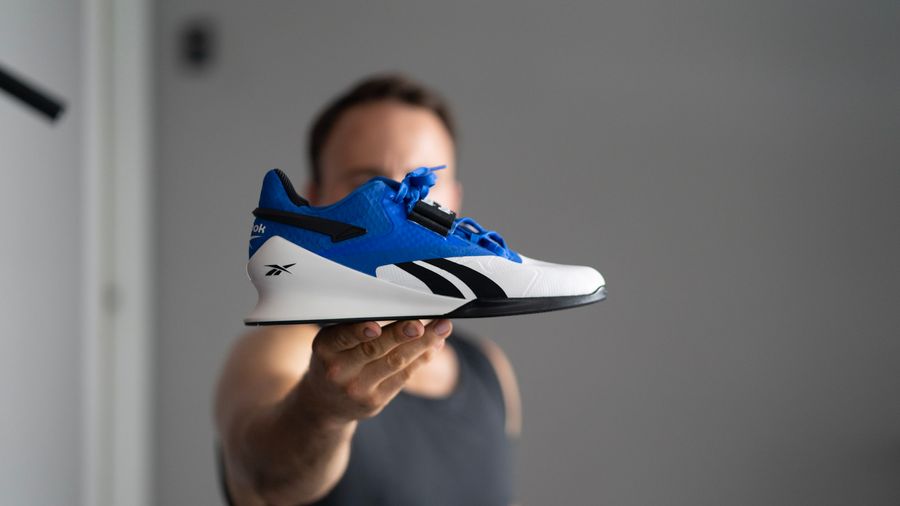
True weightlifting shoes are used to assist weightlifters during the Olympic lifts: the snatch and the clean-and-jerk. A raised heel has been shown to put lifters in a more upright stance in squats, according to a 2017 study1—ideal for competitive weightlifting. The term “weightlifting shoes” has become sort of convoluted and now encompasses a wider variety of types of training shoes, with and without a raised heel.
Technically, Olympic weightlifting shoes have a raised heel and typically use a double-closure system of laces and straps. The International Weightlifting Federation (IWF) recommends that Olympic weightlifters should wear shoes with an elevated heel of 18-20 millimeters, or about three-quarters of an inch high.
But, if you take a look at all of the lifting shoes available to you, you’ll see that they come in all different heel heights, from zero-drop to an inch. Lifting shoes with different heel heights have different purposes, and they can be worn for assistance during different types of workouts.
Take the Nike Metcons for example—our pick for the best CrossFit weightlifting shoes. These aren’t technically weightlifting shoes, but tons of people wear them to lift weights. They’re phenomenal for lightweight, high-volume workouts, as well as workouts that contain conditioning exercises in addition to resistance exercises. They’re versatile and they do a lot of things pretty well.
Now look at the Nike Romaleos 4. These are our favorite shoes for Olympic weightlifting. We wouldn’t recommend you wear them during CrossFit WODs, and certainly not for a run. In contrast to the Nike Metcons, which do many things decently, the Romaleos do one thing spectacularly well: assist with weightlifting.
So to answer the question—what do weightlifting shoes do?—it depends on what type of lifting shoes you buy.
How to Choose the Best Weightlifting Shoes
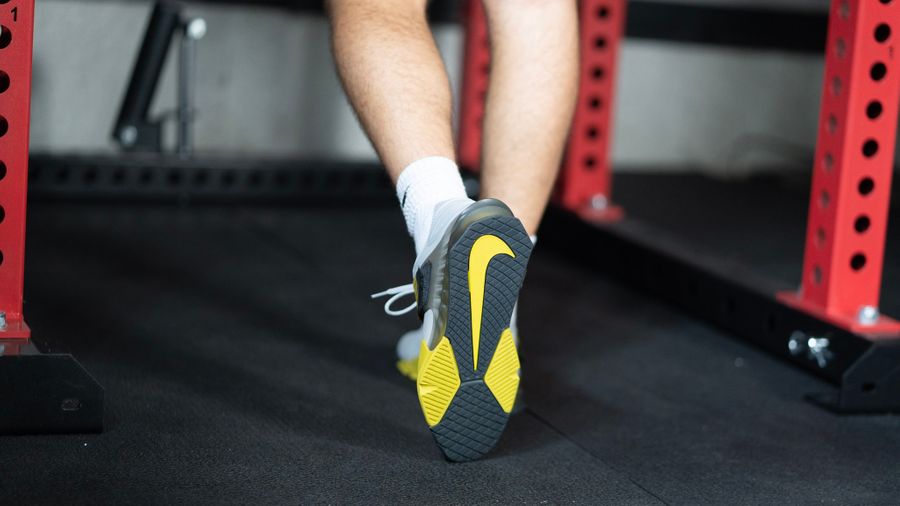
Weightlifting shoes aren’t something you want to just buy willy-nilly. A haphazard choice could result in haphazard performance. Choosing the best weightlifting shoes for you is going to involve some analysis of your weak points and trouble areas during lifts.
For example, someone who struggles with ankle dorsiflexion, and thus struggles to squat to full depth and receive the barbell in the correct position during a clean or snatch, would benefit from weightlifting shoes with a higher heel.
Here’s a full list of every factor you should consider when you’re looking to buy new weightlifting shoes.
Heel Height
Heel-to-toe drop is probably the most important factor that should go into your search for lifters. The heel height is what really determines the shoes’ effect on your range of motion: The higher the heel, the easier it is to drop into an ass-to-grass squat. The lower the heel, the less assistance with that specific aspect of lifting.
Nike Romaleos 4, Reebok Legacy Lifters 2, and NOBULL Lifters have heel-to-toe drops on the higher end of the spectrum. On the low end, you have Chuck Taylors, Nike Metcons, Reebok Nanos, NOBULL trainers, and other cross-training shoes. The Reebok Lifter PR IIs, Adidas Adipowers, Nike Savaleos, and Adidas Powerlift fall somewhere in the middle.
Closure Mechanism
You’ll see a combination of three types of closure systems on weightlifting shoes. Almost all of them have laces and midfoot velcro straps, but some have an additional closure mechanism called BOA. BOA is a third-party supplier of shoe technology, specifically a dial closure system that allows you to achieve a superbly snug fit compared to just laces and/or velcro.
None of our top picks have a BOA system because we honestly don’t think it’s necessary for the average fitness enthusiast. Inov-8 used to make a BOA version of the Inov-8 Fastlift weightlifting shoe, but they may have discontinued it, because it seems to only be available on Amazon in limited quantities and sizes.
Toe Box
The best toe box shape and size depends largely on preference and the shape of your foot, but in general, a wider toe box is better for lifting. The more room your toes have to spread out, the better you’ll be able to grip and drive into the ground and balance.
Midsole Material
If heel-to-toe drop is the most important factor in lifting shoes, the midsole is the second most important. In weightlifting shoes, the midsole is primarily the wedge—AKA the platform of the shoe that helps with your lifts.
In general, we recommend a thermoplastic polyurethane (TPU) midsole and platform for weightlifting shoes. TPU is durable and stable; it doesn’t compress greatly under heavy loads; and it won’t deform for a very long time.
Other common shoe heel materials include ethylene-vinyl acetate (EVA), stacked leather, and wood. I don’t recommend getting weightlifting shoes made with an EVA, unless it’s restricted to the insole for comfort. Stacked leather and wood both offer a classic old-school look, but aren’t as abrasion-resistant as TPU.
Heel Shape
A wide, flared heel will give you the most stable base. The Nike Romaleos 4 and Reebok Legacy Lifter II are good examples of a stable heel. A narrower but still elevated heel does not offer quite as much stability but does bring in an element of versatility—take the Adipowers, Powerlifts, and Lifter PRs for an example of a more hybrid shoe.
Upper Material
While you may not need the upper of your weightlifting shoes to be as durable as the upper of your CrossFit shoes or running shoes, it’s still a good idea to look for materials that allow for both durability and breathability. A perforated leather upper or a thick mesh upper encompasses both of those qualities.
Durability
Let’s face it: Weightlifting shoes can be expensive. So to make sure you’re not dropping hundreds of dollars every other month, make sure your shoes can withstand the grueling workouts you put them through. A more durable shoe is also more likely to protect your foot while lifting.
Final Thoughts: Do You Need Weightlifting Shoes?
Whether or not you need weightlifting shoes fall into the same vein as the question of whether or not you need a weightlifting belt. Do you truly need them? Probably not. Will they help? Totally, as long as you use them appropriately.
For the average home gym owner, weightlifting shoes are far from a necessity. I’d really only consider them a necessity for people who compete in Olympic weightlifting events. That said, weightlifting shoes can tremendously improve your chances of a successful lift, whether you’re squatting or snatching.
By providing a wider, more stable base than training shoe offer—as well as increasing ankle flexion due to the high heel—weightlifting shoes allow you to receive the barbell in a more anatomically beneficial position.
Best Weightlifting Shoes: FAQs
Why do people wear weightlifting shoes?
People wear weightlifting shoes to assist with stability and mobility during Olympic weightlifting and powerlifting, during both training and competition.
Do weightlifting shoes really help?
Yes, weightlifting shoes can certainly help improve your lifts, thanks to the subtle changes they make to your body positioning. By allowing you to access deeper ranges of motion while still keeping your torso tall and upright, weightlifting shoes put you in a better position to successfully lift heavyweight.
Why do weightlifting shoes make squats easier?
Weightlifting shoes make squatting easier because of the high heel. The elevated heel position acts as faux ankle dorsiflexion, which is a key element in proper squat positioning. Many people lack ankle mobility to achieve deep squats with an upright torso, and weightlifting shoes can assist with that.
When should I wear weightlifting shoes?
Most fitness experts generally recommend wearing weightlifting shoes during Olympic weightlifting and powerlifting workouts. While you can wear some types of lifting shoes during conditioning workouts (such as CrossFit), most aren’t appropriate for movements like burpees, box jumps or running.
Can you wear lifting shoes for running?
We recommend that you don’t wear weightlifting shoes for running unless your definition of weightlifting shoes is actually training shoes (like Nike Metcons or NOBULL Trainers). Even still, if you’re running more than 800 meters, we recommend just getting some running shoes.
RELATED: How to Choose Running Shoes
References
- Legg, H. S., Glaister, M., Cleather, D. J., & Goodwin, J. E. (2017). The effect of weightlifting shoes on the kinetics and kinematics of the back squat. Journal of sports sciences, 35(5), 508–515. https://doi.org/10.1080/02640414.2016.1175652


